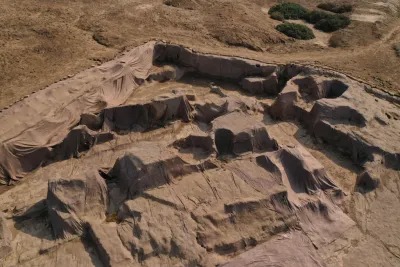
DHI QAR, IRAQ – NOVEMBER 15: British Museum and Iraqi archaeologists carry out excavations in the ancient city of Girsu, the capital of the Kingdom of Lagash in Dhi Qar, Iraq on November 15, 2021. (Photo by Arshad Mohammed/Anadolu Agency via Getty Images)
Archaeologists have uncovered a large tavern complete with benches, a type of ancient clay refrigerator called a “zeer”, an oven, and storage containers, some of which still had food, outside the modern city of Al-Shatrah in southern Iraq, according to Penn Today.
The tavern was found by researchers from the University of Pennsylvania and the University of Pisa in Italy using advanced methodologies and high-tech gear, including drone photography, thermal imaging, and “micro-stratigraphic sampling, a surgically precise type of excavation” at Lagash, one of the largest archaeological sites in what once was Mesopotamia.
Related Articles
Archaeologists Discover Remains of 4,500-Year-Old Lost Ancient Palace in Iraq
Archaeologists May Have Found the Oldest Known Mummy in Egypt
The part-open-air, part-kitchen public house dates to around 2,700 B.C.E. was discovered by what the project manager Zaid Alrawi describes as a modern approach to excavation.
“It’s not like old-time archaeology in Iraq,” he told Penn Today. “We’re not going after big mounds expecting to find an old temple. We use our techniques and then, based on scientific priority, go after what we think will yield important information to close knowledge gaps in the field.”
One such method involves excavating “microstratigraphic layers” around 20-inches deep across a wide swath of land which Lagash project director Holly Pittman described as similar to “doing very careful surgery.”
In previous rounds of excavation, researchers uncovered evidence that Lagash, which was made up of three settlements, Girsu, Lagash, and Niĝin, was not only a hub for political and religious activity but also a “significant population center with people dedicated to intensive craft production.”
Drone images and magnetometry, which records the magnetic intensity of features underground, revealed the Lagash site’s layout and led the researched to uncover six ceramic kilns with oval pits made of baked mudbrick. After a short, pandemic-related hiatus, excavations began again in 2022 and five more kilns were discovered.
With each discovery at Lagash, new details of the people who lived in southern Mesopotamia came into focus.
“As you excavate, you analyze and create a story that we hope gets closer and closer to the reality of the past,” Alrawi told Penn Today.

Leave a Reply